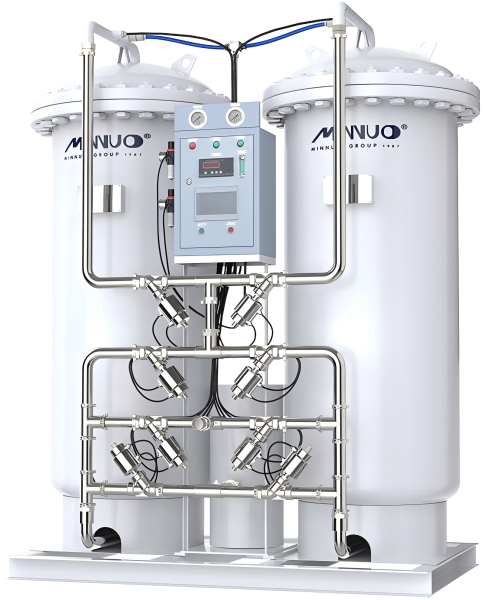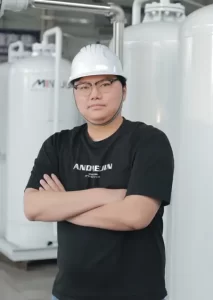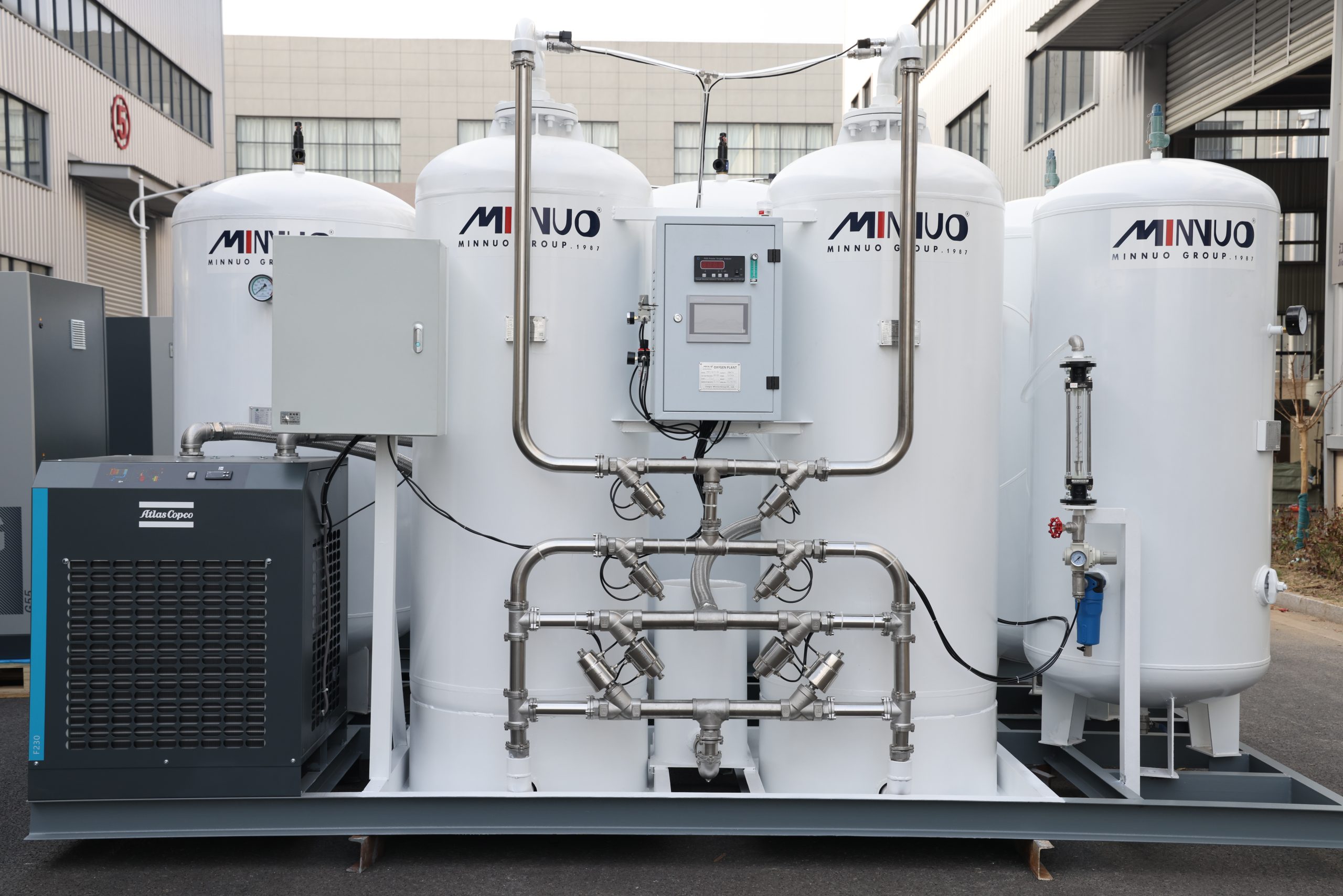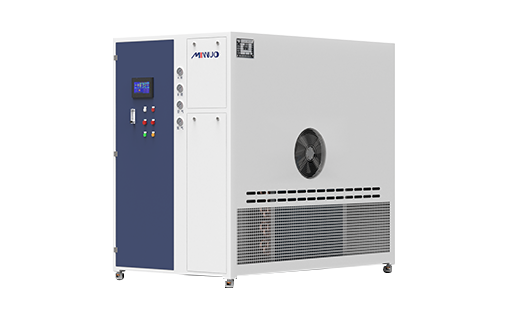A PSA Nitrogen Generator is a highly efficient nitrogen separation device based on the principle of physical adsorption. This article explores its working principle, technological innovations, industry applications, and future development trends to help you understand this key technology.
The PSA Nitrogen Generator uses carbon molecular sieves (CMS) to separate nitrogen and oxygen via periodic pressure changes, producing nitrogen with a purity range of 95%–99.9995%. Suitable for industries like semiconductors, food packaging, and chemicals, its core advantages include environmental friendliness (no pollution), low cost, flexible purity/flow adjustments, and energy-saving technologies (e.g., frequency-controlled compressors, waste heat recovery).

I. Technical Definition and Core Value
The PSA Nitrogen Generator is an industrial device that separates nitrogen and oxygen using gas molecular dynamics. Leveraging CMS’s selective adsorption of oxygen and periodic pressure changes (0.6–1.0MPa high-pressure adsorption → atmospheric pressure desorption), it delivers nitrogen meeting diverse needs (e.g., food packaging to semiconductor manufacturing). Its core value includes:
- Pollution-Free Physical Adsorption: No chemical agents, compliant with ISO 14001.
- Low-Cost On-Demand Production: Reduces investment payback period to 12–18 months versus liquid nitrogen procurement.
- Flexible Purity/Flow Control: PLC system enables real-time adsorption cycle adjustment for industry standards.
II. In-Depth Technical Breakdown
1. Compressed Air Pretreatment System
- Three-Stage Filtration: Removes oil, dust, and water (dew point ≤ -40°C) to protect molecular sieves and enhance purity.
- Air Buffer Tank: Stabilizes air pressure to prevent adsorption tower efficiency fluctuations.
2. Dual-Tower Adsorption-Regeneration Cycle
- Adsorption Phase (60–120 seconds): Compressed air enters Tower A; CMS preferentially adsorbs oxygen (faster diffusion, 2.8Å diameter vs. nitrogen’s 3.0Å), enriching nitrogen output.
- Equalization Phase (2–3 seconds): High-pressure nitrogen from Tower A balances the pressure in Tower B to reduce energy consumption.
- Desorption Phase (30–60 seconds): Tower A depressurizes to release oxygen; Tower B switches to adsorption for continuous gas supply.
3. Regeneration Optimization
- Backflush Process: Uses produced nitrogen to flush towers, removing residual oxygen.
- Anti-Powdering Design: Self-compensating cylinder compression extends CMS lifespan to 8–10 years.
III. Technical Comparison
| Parameter | PSA Method | Membrane Separation | Cryogenic Method |
| Nitrogen Purity | 95%–99.9995% | 90%–99.5% | 99.999%+ |
| Startup Time | 3–5 minutes | Immediate | Several hours |
| Energy Consumption | 0.35–0.5kW·h/Nm³ | 0.3–0.4kW·h/Nm³ | 0.8–1.2kW·h/Nm³ |
| Applicable Scenarios | Medium/small flow | Mobile/low purity | Large-scale industry |
(Data source: Technical Parameter Comparison, websites 3, 6, 9)
IV. Innovations in MINNUO PSA Generators
1. Energy-Saving Technologies
- Frequency-Controlled Compressors: Adjust energy use based on demand, saving up to 80% energy.
- Waste Heat Recovery: Preheats incoming air using tower pressure-relief heat.
2. Intelligent Control
- Siemens PLC + IoT: Monitors purity, flow, and dew point in real time; supports Modbus/Profibus for DCS integration.
- Self-Adjusting Algorithm: Optimizes cycles via zirconium oxide sensors, ensuring purity fluctuations ≤±0.5%.
3. Modular Design
- Skid-Mounted Structure: Integrates components, reducing footprint by 50%.
- Multi-Tower Parallel Technology: Supports flow expansion (20–3000Nm³/h) for high-demand industries (e.g., lithium batteries).
V. Industry Applications
1. Electronics & Semiconductors
- Chip Packaging: 99.999% nitrogen prevents copper wire oxidation (e.g., Dongyu generators with real-time monitoring).
- 3D Metal Printing: Inert environment avoids titanium alloy oxidation, ensuring part density.
2. Food & Pharmaceuticals
- Modified Atmosphere Packaging (MAP): 99.9% nitrogen extends meat shelf life by 30–50% (with vacuum packaging).
- Freeze-Dried Drugs: Sterile nitrogen meets GMP standards, preventing hydrolysis.
3. Energy & Chemicals
- Pipeline Purging: 99.95% nitrogen inerting complies with ATEX explosion-proof standards).
- Tank Protection: Maintains positive pressure to prevent VOC emissions.
4. Emerging Fields
- Hydrogen Batteries: Dew point ≤ -70°C nitrogen dries electrodes, preventing proton membrane failure.
- Carbon Capture (CCS): PSA separates CO₂; nitrogen aids enhanced oil recovery.

VI. Key Technical Parameters
| Parameter | Standard Range | High-End Configuration |
| Nitrogen Purity | 95%–99.9% | 99.999% (with post-purifier) |
| Operating Pressure | 0.7–1.0MPa | 3.0MPa (CNG stations) |
| Dew Point | ≤ -40°C | ≤ -70°C (electronics-grade) |
| Molecular Sieve Life | 8–10 years | 20 years (MINNUO high-density filling) |
| Control System | Local PLC | IoT remote + AI predictive maintenance |
Selection Tips:
- Electronics/Pharma: Prioritize 99.999% purity models with zirconium sensors.
- Food/Metallurgy: Focus on flow stability; consider dual-tower redundancy with liquid nitrogen backup.
VII. Maintenance & Cost Optimization
1. Routine Maintenance
- Filter Replacement: Pre-filters every 3 months (1 month in dusty environments).
- CMS Inspection: Annual tests; regenerate if adsorption capacity drops >15%.
2. Fault Warnings
- Pressure Anomaly: >0.15MPa difference signals tower clogging.
- Purity Drop: O₂ >50ppm requires valve seal checks.
3. Cost Control
- Energy Use: Compressors account for 70% of costs;use permanent magnet frequency-controlled models.
- CMS Replacement: Imported sieves cost ~15% of equipment; poor filling can triple maintenance costs.
VIII. Trends & Outlook
- Material Innovation: Zeolite imidazole frameworks (ZIFs) boost O₂ adsorption by 30% and reduce energy use.
- Hydrogen-Nitrogen Co-Production: Integrates PSA with electrolytic hydrogen for new energy sectors.
- Digital Twin Technology: AI models predict failures and optimize efficiency using operational data.
IX. FAQ (Frequently Asked Questions)
1. What is the typical lifespan of a PSA Nitrogen Generator?
The typical lifespan of a PSA Nitrogen Generator’s molecular sieve is 8-10 years, depending on operating conditions. However, with the advanced design used in MINNUO’s systems, the lifespan can be extended to up to 20 years with high-density filling technology.
2. How do I choose the right purity level for my PSA Nitrogen Generator?
The required purity level depends on your industry’s specific needs. For industries like electronics and pharmaceuticals, 99.999% purity is recommended to ensure high-quality production. For food or metallurgical applications, a purity range of 95%-99.9% is typically sufficient.
3. Can a PSA Nitrogen Generator be used in hazardous environments?
Yes, PSA Nitrogen Generators can be used in hazardous environments. For example, the 99.95% nitrogen output can be used for inerting and purging oil and gas pipelines, meeting ATEX explosion-proof safety standards.
4. How often should the molecular sieve in a PSA Nitrogen Generator be replaced?
The molecular sieve in a PSA Nitrogen Generator should be inspected annually. If the adsorption capacity has declined by more than 15%, regeneration should be activated. If it continues to degrade, replacement may be necessary.
5. Can I monitor the performance of my PSA Nitrogen Generator remotely?
Yes, MINNUO’s PSA Nitrogen Generators come with IoT-enabled remote monitoring systems. You can track performance parameters such as purity, flow rate, and dew point in real-time, ensuring efficient operation and proactive maintenance.
6. What industries benefit most from PSA Nitrogen Generators?
PSA Nitrogen Generators are widely used across various industries, including:
- Electronics & Semiconductors: For chip packaging and 3D printing metal powders.
- Food & Pharmaceuticals: For modified atmosphere packaging (MAP) and sterile nitrogen production.
- Energy & Chemicals: For oil and gas pipeline purging and tank protection.
- Emerging Industries: Including hydrogen energy batteries and carbon capture and storage (CCS).
7. How energy-efficient are PSA Nitrogen Generators?
PSA Nitrogen Generators are highly energy-efficient, especially when paired with advanced features like frequency-controlled compressors and waste heat recovery systems. These innovations can reduce energy consumption by up to 80%, significantly lowering operational costs.
X、Conclusion
PSA Nitrogen Generators continue to enhance energy efficiency and expand into emerging fields. MINNUO’s intelligent, modular designs offer reliable, cost-effective solutions, empowering industries to achieve higher productivity in evolving markets.






 sales2:+86 17506119168
sales2:+86 17506119168

